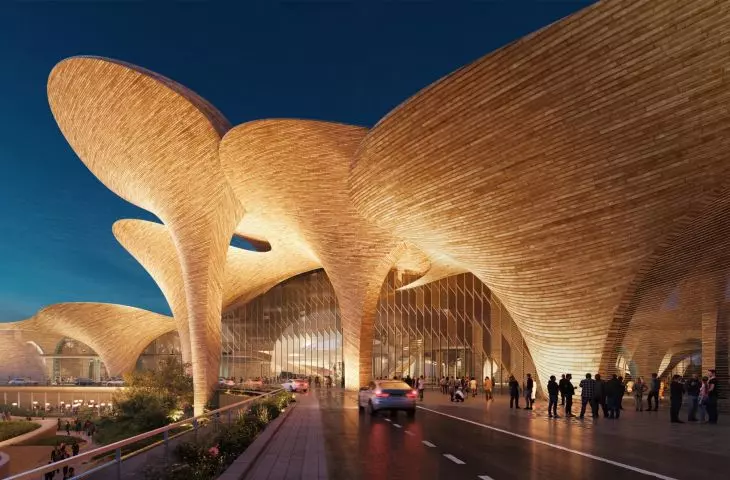Ali Sher Nawoi Institute,
designed by Zaha Hadid Architects
Studio Zaha Hadid Architects (ZHA) presents a new design for the Ali Sher Nawoi Institute in New Tashkent, Uzbekistan. The complex, with a floor space of 29,000 m², will include the Nawoi State Museum of Literature and a 400-seat auditorium for performances, conferences and cultural events. The project will also include the establishment of an International Research Center and a boarding school for 200 students, focused on developing competencies in Uzbek language, literature and music.
cultural foundation
for a growing city
The center will form the foundation of the planned cultural district of New Tashkent. The 25,000-acre site was planned by Cross Works, in response to the needs of the growing metropolitan area. The institute, named after Ali Sher Nawoi - a renowned vizier, poet and linguist from the 15th century - aims to support and develop Uzbek literary and cultural heritage.
The Ali Sher Nawoi Institute for International Scientific Research in Tashkent - visualization on the building from a bird's eye view
© Norviska
spaces supporting education
in New Tashkent
The 23,000-square-meter main part of the complex was designed as a network of interconnected volumes with organic, funnel-shaped forms, which were shaped like traditional wind catchers used in the Central Asian and Middle Eastern region. Such structures with hollow interiors allow natural air circulation, directing air flow deep into the building and providing cooling during summer periods. On windless days, these blocks will act as thermal chimneys, using the pressure gradient to regulate the temperature inside the building.
Ali Sher Nawoi Institute for International Scientific Research in Tashkent - visualization
© ZHA
form along the lines of regional wind catchers
and passive solutions
During the hottest months, the natural cooling system will be assisted by fans and water mists, ensuring thermal comfort with minimal energy consumption. Deep canopies will protect the facades from the sun in the summer, and in the winter will allow optimal sunlight for the interiors. The idea for the buildings' design is inspired by local Uzbek architecture, and the use of bricks produced in the traditional kilns of Tashkent allows a visual connection between modern forms and local architectural culture.
Ali Sher Nawoi Institute for International Scientific Research in Tashkent - sunshine analysis
© Buro Happold
brick and glass as basic
building materials
The space between the brick blocks will be filled by a glazed facade, which will bring natural light into the interior and open the building to the surrounding courtyards. These courtyards - a characteristic element of the region's architecture - will not only provide light to the interiors, but also support natural ventilation and create meeting places.
Ali Sher Nawoi Institute for International Scientific Research in Tashkent - interior visualization
© Norviska
passive construction
in response to the region's climate
The center has been designed in accordance with the principles of passive construction, which will help maintain optimal conditions for users while minimizing energy consumption.
Ali Sher Nawoi Institute for International Scientific Research in Tashkent - sunshine diagram
© ZHA
Nawoi State Museum of Literature
As the heart of the project
The central part of the institute will house the Navoi State Museum of Literature, dedicated to literature research and the preservation and promotion of Uzbekistan's literary heritage. The museum, consisting of 13 exhibition halls, will collect and display valuable manuscripts, books and archival materials. The facility will also include a conservation workshop and storage for collections of historical value.
Ali Sher Nawoi Institute for International Scientific Research in Tashkent - visualization.
The institute's design draws inspiration from traditional Uzbek cultural forms and patterns, while providing modern spaces for education and culture. The architecture, rooted in local traditions, promotes a contemporary interpretation of historical elements, creating a multifunctional center that will become a space for dialogue and creativity, open to the local community and visitors from around the world.
Elaborated: Anastazja Dżupina
Illustrations provided courtesy of Zaha Hadid Architects.














































